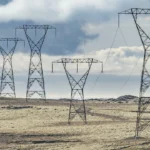Energy News Beat
After 15 years, the Bureau of Land Management finally approved a 732-mile transmission line that will send 3,000 megawatts of power from the Sierra Madre and Chokecherry wind energy projects in Wyoming to renewable-hungry California.
The $3 billion project, which will run across Colorado, Utah and Nevada, will require another five years of construction before it’s operational, and there was a lot of planning and engineering that preceded the permitting process.
A group of Princeton University academics released a report in 2020 that estimated that, to reach net zero targets, the U.S. will need to increase its transmission capacity by 3.2 times its existing infrastructure by 2050.
The TransWest 20-year permitting and construction timeline is typical, meaning it’s unlikely that massive buildout capable of meeting that goal will ever be achieved without major changes to the permitting process.
Net Zero By 2163
The National Renewable Energy Laboratory estimated that if the U.S. got 90% of its electricity from renewable sources, it would need to build twice as much capacity as its current 240,000 miles of high-voltage power lines nowcarry.
Writing in his Substack in February, energy expert Robert Bryce calculated that it would require a transmission line long enough to circle the Earth nearly 10 times.
Based on data from C Three Group, which tracks the growth of energy infrastructure, Bryce determined that the U.S. high-voltage transmission system grew by about 1,700 per year between 2008 and 2021. That means doubling the size of this transmission capacity will take about 140 years at the current rate.
Spreadsheet Manipulation
All of the projections of what is needed, Bryce notes, don’t factor in local opposition that will certainly grow as more transmission lines cross private property, as it has with renewable energy projects.
Energy author and analyst Meredith Angwin told Cowboy State Daily that renewable energy targets aren’t set without a lot of forethought concerning the kinds of obstacles they’ll encounter, including the thousands of miles of transmission lines and storage facilities that will be needed to stabilize a grid with large amounts of intermittent wind and solar placed on it.
“It gets to be a little bit of a spreadsheet manipulation experience rather than actually a planning experience,” Angwin said.
People tend not to settle in areas where the winds are ideal for wind farms, Angwin said. That means that energy will have to be transported from where it’s produced in rural areas to where it’s consumed, most of which will be in population centers.
That’s unlike a nuclear power plant, for example, which can be sited just about anywhere there’s a water source.
Rolling Blackouts
In her book “Shorting The Grid,” Angwin analyzes what she says are problems stemming from a lack of accountability and grid governance.
She predicts that if the United States continues down its current path, people likely see more rolling blackouts and rising electricity rates, which is already happening.
The needed transmission is one problem the book covers, and the lengthy permitting process with TransWest is hardly unique.
Transmission lines tend to be more difficult to site than the average project, Angwin explained in an interview, because they have to go through multiple jurisdictions.
The TransWest project needed approval from the BLM, state governments, U.S. Forest Service and the Department of Energy, in addition to handling disputes with private landowners.
Permitting Reform
In Vermont, Angwin said, transmission lines meant to bring hydroelectric power from Canada to Boston and New York have been blocked by local opposition for over 20 years.
The lines had to pass through New Hampshire, but that state didn’t want it.
“It wasn’t going to help New Hampshire,” Angwin said.
A 500-mile transmission line crossing New Mexico and Arizona, the SunZia project, has been in the permitting process for 17 years, and local opposition concerned about its impacts to wildlife continue to stall the project.
A recent report by Americans for a Clean Energy Grid identifies 22 high-voltage transmission projects that would go forward if “more workable transmission policies were enacted.”
Progressives, who are the most vocal proponents of renewable energy, also are the most vocal opponents of attempts to reform the permitting process that would allow faster construction of all kinds of industrial development, including wind farms, solar farms and transmission lines.
Sen. Joe Manchin, D-West Virginia, attempted to reform the permitting process last year, which would have shortened the federal environmental review process from 4.5 years to two years.
Prominent progressives successfully fought the effort.
ENB Top News
ENB
Energy Dashboard
ENB Podcast
ENB Substack
The post After 15 Years Of Permitting, TransWest Wind Transmission Project Is Still 5 Years From Going Live appeared first on Energy News Beat.








